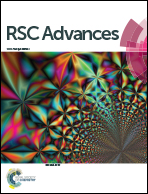Phosphoric acid-assisted synthesis of layered MoS2/graphene hybrids with electrolyte-dependent supercapacitive behaviors†
Abstract
A reformative graphene-supported MoS2 hybrid has been synthesized by a phosphoric acid (H3PO4)-assisted hydrothermal process. The effect of H3PO4 on the growth, morphology, structure, and composition of the MoS2/graphene hybrid has been explored by scanning electron microscopy (SEM), X-ray diffraction (XRD), Raman spectroscopy, and X-ray photoelectron spectroscopy (XPS). The results indicate that H3PO4 can control the process of both the reduction of graphene oxide and the crystallization of MoS2. The electrochemical performance suggests that involvement of H3PO4 in the reaction bestows the hybrid with electrolyte-dependent capacitive behaviors in which contribution from electric double-layer capacitance (EDLC) and pseudocapacitance can be distinguished in acidic and alkaline electrolytes, respectively. While the quasi-EDLC behavior of the hybrid dominates in an alkaline electrolyte (258 F g−1 at 2 A g−1), the pseudocapacitance of the hybrid in an acidic electrolyte can be significantly enhanced due to oxygen-containing groups and Mo active in the total capacitance value (351 F g−1 at 2 A g−1). Moreover, a superior cycling performance and quick frequency response of the hybrid reinforces its potential for supercapacitor applications.



 Please wait while we load your content...
Please wait while we load your content...